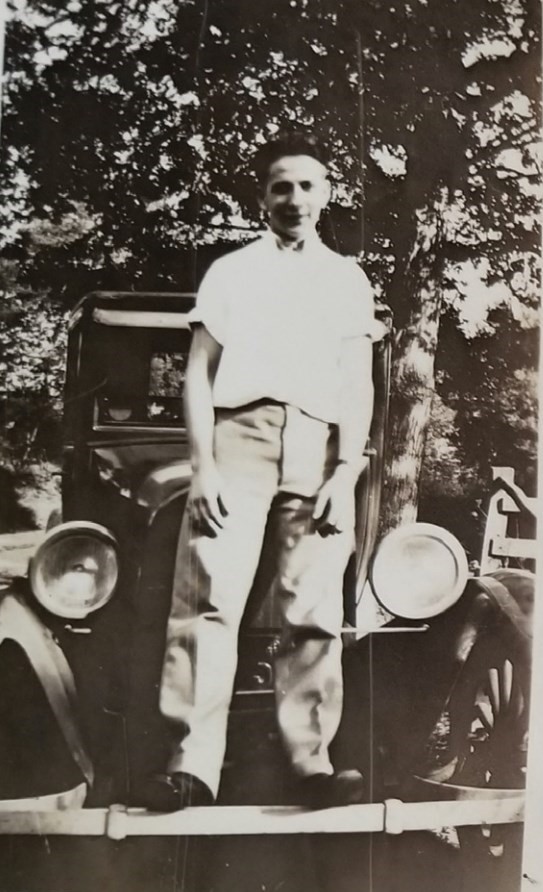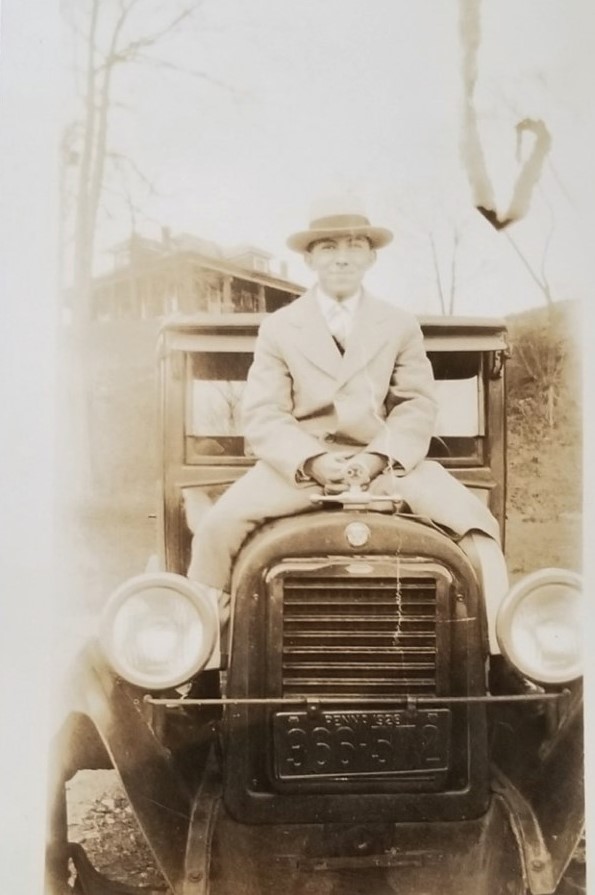The “car” bug bit deeply into our family line by 1921 when my grandfather, Lester W. Hobaugh, was a teenager. Adopted by his Aunt Nora and Uncle Joe Bowersox, Lester grew up on a farm just outside the City of York. He and Uncle Joe delivered grain to other farmers in a REO Speed-Wagon with an extended bed, America’s first pick up truck. But Uncle Joe also drove Studebakers. Lester loved motor vehicles and he drove them whenever he could. Lester excelled in mathematics and machine shop so between a scholarship and selling eggs from the farm, he paid for a Penn State education. While in high school and college, Lester’s best friend was Richard Mole, who went on to become a minister. Attached are pictures of Lester and Richard “hanging around” with cars. I believe the 1928 Dodge Brothers was Lester’s car. He and Richard appear standing on the front bumper of another car. If you can identify it, please let me know.

After college, Lester took a job teaching machine shop at Pottsville High School in 1929. Following a blind date set up by Richard, Lester courted Cleo Fourhman of York. They married and took a honeymoon in the Dodge Brothers car. Soon after their wedding, Lester and Cleo moved to 20th and Mahantongo Streets in Pottsville. I visited there after our Fall Foliage Tour. Their car was a 1924 Marmon 4-passenger phaeton that Lester bought used but in great shape. Why would a school teacher buy a Marmon? Probably because he was a machinist and they represented a quality car with great engineering.
Marmons were manufactured by the Nordyke & Marmon Company in Indianapolis, Indiana, a successful flour business that Howard Marmon steered toward motor vehicles. In 1909 Marmon introduced the Model 32, its first successful car with a water-cooled engine. A version of this car known as “The Wasp” won the first Indianapolis 500 race in 1911 driven by Ray Harroun. Lester probably thought he was getting a fast car with some prestige.

Their Marmon Model 34 had a six-cylinder overhead valve engine that produced 34 horsepower but much more torque. According to my late friend, Beverly Rae Kimes, “its cylinder block and most engine components (including pushrods) were aluminum, as was the entire body and radiator shell.” Kimes and Clark, Standard Catalogue of American Cars 1805-1942, (2d Ed. 1988), page 885. This is consistent with what my grandparents told me: a light-weight car with plenty of “get up and go.” It got them home quickly from card games in Pottsville and took them on long trips. They drove once to Niagara Falls and at least once to visit family in North Carolina.
But the roar of the twenties ended in the Great Depression and for Lester, being married with a family and responsibilities. Fortunately, his teaching job covered the bills and contributed to the needs of his brother-in-law’s family. That left few dollars for another “hot” car but Lester still sought great quality. Uncle Joe gave Lester a series of Studebakers. Each time he made a “gift” to the young couple instead of trading in his Studebaker. Those cars served them after they moved to Carlisle where Lester taught at the Carlisle High School and later set up crystal factories for the war effort in 1942.

After WWII, Lester ran the state program for distribution of military surplus property in Pennsylvania and had an office in the State Capitol Building. Next, he taught at York High School. His son (my father), Bob Hobaugh, Sr., persuaded Lester to purchase a slightly used 1948 Cadillac with the new style P-38 tail fins, the last model with an L-head V-8 engine. That began a series of Cadillac purchases, all used vehicles, together with a Chevrolet panel truck that I remember. By the mid-1950s, Lester returned to the business world where he taught machine shop and mathematics to employees at the York Corporation. He helped my father rebuild a Cushman scooter and do a valve job on Bob Sr.’s 1949 Studebaker DeLuxe sedan 4-door. Lester drove a 1952 Cadillac Series 62 with a 331 cubic inch overhead valve engine and then a 1956 Cadillac Series 62 with 365 cubic inch overhead valve engine, both 4-door sedans. Sadly, Lester passed away in 1960 at age 52, leaving my grandmother, Cleo, the task of selling his machine shop in the basement, the panel truck and the last of the Cadillacs. The “car bug” had bitten my father by that time so it should come as no surprise that he became a motorhead too.
